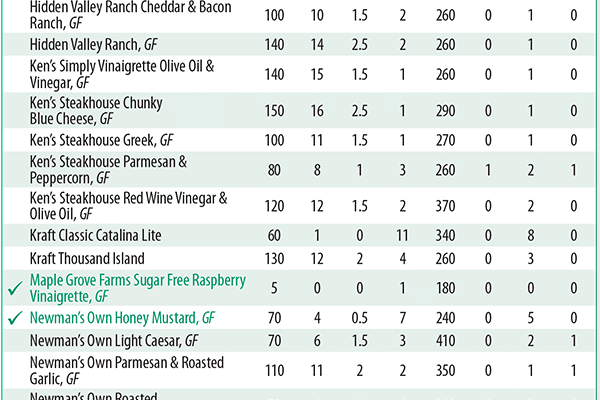Shoppers’ Guide: Salad Dressings
Whether you’re having a big salad as a meal or a small side salad with your meal, how you choose to top your salad could make the difference between an uber-healthy bowl of veggies or a bowl of fat, sugar, and/or salt along with a few greens. There’s no arguing that salads, made up of greens, peppers, carrots, tomatoes, and other vegetables, are loaded with an array of nutrients. But the extras such as croutons, bacon, cheese, and salad dressings can add significant amounts fat, calories, and sodium if you’re not careful.
Salad dressings can add delicious flavors to your salads but those two little tablespoons can also add up to 170 calories, one-quarter of a day’s sodium, and one-and-a-half fast food cheeseburger’s worth of fat to those salads. That doesn’t mean you should skip the dressing altogether. Aside from flavor, dressings, especially the full fat kind, also provide benefits. Several of the vitamins found in standard salad ingredient, specifically vitamins A and K, are what’s called fat-soluble vitamins. To maximize their absorption by your body, they need to be eaten along with some fat.
Helpful Hints. Keep these ideas in mind when creating your next salad.
Go easy on the pour. It can be easy to go overboard on the two-tablespoon serving size portion size and therefore easy to go overboard on the fat, sodium, etc. Keeping the dressing on the side of your bowl and dipping each bite into it really can help control how much you eat.
Skip the creamy. Oil and vinegar-based dressings usually offer less fat and calories than their cream-based counterparts. If the vinegar-style isn’t your thing, try using a smaller serving size.
Sweetness. If you’re watching your sugar intake, you might want to skip the “lite” or fat-free dressings. They often add more sugar when removing fat.
—Heidi McIndoo, MS, RD

The post Shoppers’ Guide: Salad Dressings appeared first on University Health News.
Read Original Article: Shoppers’ Guide: Salad Dressings »
Powered by WPeMatico


